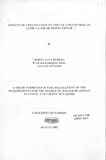| dc.description.abstract | One of the most significant dynamics impacting on Kenyan society is rapid urbanization.
The growth of urban centres across the country is proof of this process and is now an
accepted fact. Yet the track record of Kenyan cities and towns in managing the
urbanization process, when measured in terms of the performance and outlook of urban
environment, resulting from current planning practice is abysmal. This urbanization
process manifests itself more at the outskirts of urban centres- the fringe. It is at these the
fringe areas, that the dynamics of urban growth are concentrated.
The purpose of this study was to highlight the effects of urbanization on the use and
control of land in a chosen fringe area of Nairobi- the Ngong area. In Ngong, the
urbanization process manifests itself in sprawl and overspill from the city of Nairobi. All
sorts of pulls, pushes and pressures accompany the land development process in Ngong.
An effect of such events was that built-up areas had been permitted to coalesce to form 'a . weak pattern of urban growth'.
The study hypothesized that low levels of controls in land uses have influenced the
current haphazard growth pattern in Ngong. It was also assumed that the presence of
cheap land had accelerated urban growth patterns in the area. The study's objectives were
thus: to examine the impact of urbanization processes on land uses in Ngong; to identify
the institutions that are responsible for controlling use of land in Ngong with a view of
evaluating their efficiency: to highlight the most common problems, constraints and
challenges in the implementation and administration of land control measures in the study
area: and finally to propose an alternative policy framework for establishing a more
effective planning and control system.
The study revealed that, an area that ,had been typically rural had gradually evolved into
an urban environment. It was also recognized that past patterns of settlement in the
Ngong area had developed without much urban planning. Planning for urbanization in
Ngong was therefore admittedly out of step with the spirit in which the study area had
been founded, as a rural community. It was also found that amidst all these dynamic
processes, was a static phenomena reflected in the existing institutional framework which
had failed to capture the speed and nature of this urban growth by providing adequate
services. Difficulty had therefore been experienced in filtering urban developments into a
coherent growth pattern. The study area therefore became a place of many competing
interests, which lack adequate institutions to stake the balance needed to protect the
environment and maximise productivity of human resources.
A combination of constant change, complex social structure, uncoordinated institutions,
and a shifting locus meant that the area must be addressed with an approach different
from the one conventionally applied to rural areas and urban areas.
The study therefore recommended that there was need to coordinate all the planning
institutions in the study area under one umbrella peri-urban body that would oversee and
coordinate all land use planning and control activities both in Ngong but other fringe
areas bordering Nairobi city. The study argued that the planning process in the area
should be improved to ensure that most of the costs of urban growth be identified and the
benefits retained for sustainable development and urbanization. | en_US |

